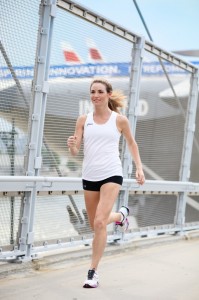 It’s been a hot second since my last blog post. I feel like I blinked, and we went from the end of 2015 to Spring 2016. My apologies, fellow runners and devote readers! I promise my posts will be back on track. There have been some big changes here – both personal and professional. If you are a New Yorker, you know that moving is perhaps the worst thing ever. Well, I’m happy to say I have found an amazing apartment, but am now in the downsizing and packing process. I am reminded when stress strikes to take a deep breath and go for a run. I always feel better. So if you are dealing with life stress, remember that 30-60 minutes to go clock some miles will always do your body, brain and happiness some good.
It’s been a hot second since my last blog post. I feel like I blinked, and we went from the end of 2015 to Spring 2016. My apologies, fellow runners and devote readers! I promise my posts will be back on track. There have been some big changes here – both personal and professional. If you are a New Yorker, you know that moving is perhaps the worst thing ever. Well, I’m happy to say I have found an amazing apartment, but am now in the downsizing and packing process. I am reminded when stress strikes to take a deep breath and go for a run. I always feel better. So if you are dealing with life stress, remember that 30-60 minutes to go clock some miles will always do your body, brain and happiness some good.
Anyway, enough personal stuff. Let’s get to the fun and the RUNNING!!!! As of May 1st, 2016, Coach Corky is a full-time employee at Mile High Run Club. This means you can find me on the schedule at least 15 classes per week. You can find me at both the NOMAD and NOHO locations, teaching all three classes – Dash 28, High 45, and The Distance.
Hopping into a full time position doesn’t mean Coach Corky Runs, LLC is slowing down at all. In fact, it’s that time of year where my athletes heading to Brooklyn Half Marathon are tapering, and runners with Autumn goals (RnR BK Half, NYC Marathon, Chicago Marathon, Philly Marathon) – I’m looking at you – are reaching out for training plans and one-on-one coaching. It is insanely busy in the best way possible! I am truly humbled by the humans I coach.
Aside from the coaching, this little lady has been getting her legs back to the starting line of some races! It’s been a process to regain speed after some serious time spent on Ultra Marathons, but I’ve successfully found my groove and podium again. In fact, in my first three races of 2016, I finished in the top 3. That streak obviously couldn’t last, and didn’t when I toed the line with 30,000+ runners for the Broad Street Run. While I missed my goal for my A race for Spring, I am trying to not beat myself up and take the advice I’d give my runners after a bad race – but that advice is easier to give than receive.
As you ease into your Summer training and Autumn goals, please be mindful of the importance of building base mileage. This is a very important step in training, and one we often gloss over as we are eager to jump into the intense work. Skipping this step can raise risk of injury. Base mileage for 3-6 weeks will lend itself well to your training and race day fitness.
 As one calendar year is about to come to a close and we look to the New Year, fitness and health frequently take center stage. This is often a time of reflection on the previous year – races, health, nutrition, happiness, and a time of anticipation and dreams for the future – getting health or weight on track, attempting your first race, working to set new personal race records, trying a new sport, dropping a dress size, sweating on a daily basis, gaining muscle, eating a balanced diet – the dreams and possibilities are endless!
As one calendar year is about to come to a close and we look to the New Year, fitness and health frequently take center stage. This is often a time of reflection on the previous year – races, health, nutrition, happiness, and a time of anticipation and dreams for the future – getting health or weight on track, attempting your first race, working to set new personal race records, trying a new sport, dropping a dress size, sweating on a daily basis, gaining muscle, eating a balanced diet – the dreams and possibilities are endless!





